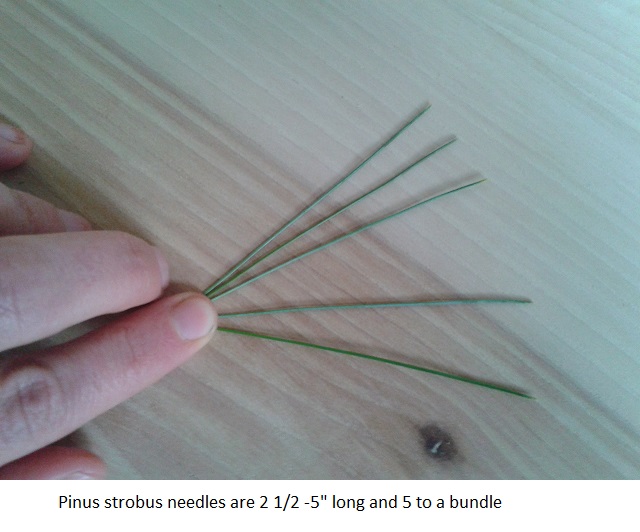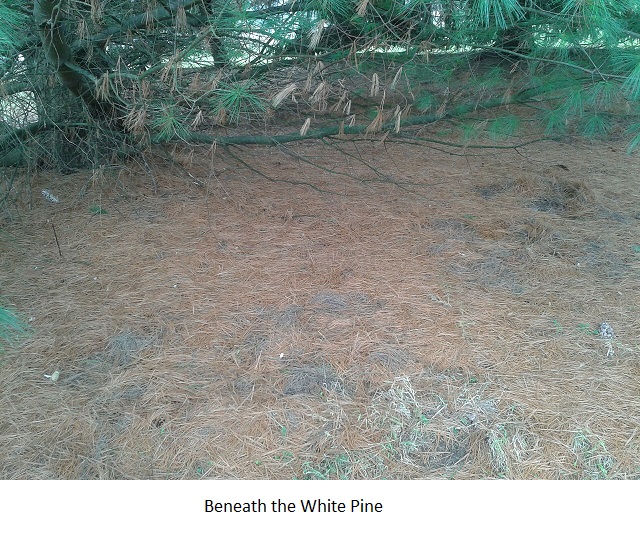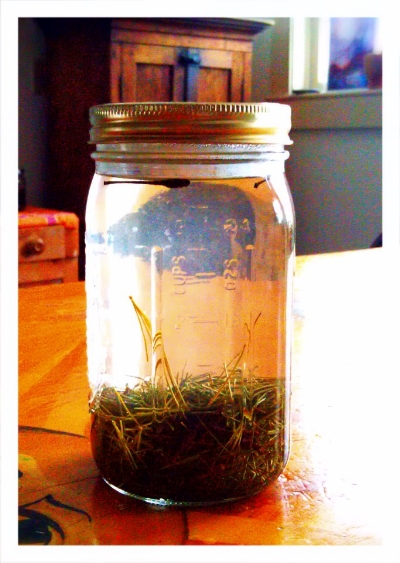Getting To Know White Pine
White Pine or Pinus strobus is the tallest tree native to the Adirondack forest;growing up to 150-200'+ with up to an 8' diameter, and was considered sacred by the First Nations of the Haudenosaunee(Iroquois). The White Pine was widely overharvested and more or less clear cut by European colonists but, thankfully, there are still several small old growth forests left in the mountains. These are also easy trees to grow and cultivated in any backyard in the Northeast, although they do best in acidic soil and, in fact, the needles are highly acidic when they fall(3.5) helping to create the necessary conditions for its survival.This will limit the growth of any plants below it with the exception of acid loving plants such as blueberries. I have 3 White Pines in my yard that I never have to mow under because the surface below them is nothing but a sweet bed of Pine needles.
This tree is not only tall and majestic, but is an excellent source of medicine especially for the upcoming Winter months. It is considered a food source and is highly nutritious, but mostly used as a last resort starvation food by the First People. The inner bark can be eaten and, both the bark and needles are high in Vitamin C. The nutritional value of White Pine was not widely known by the first European settlers when they arrived here and many of them died of scurvy in the forests below these Vitamin C filled trees. I have heard many variations of myths from the First People about the White Pine. It is commonly thought that word "Adirondack" means "bark eater". I was taught by an ecology professor that there was no food growing beneath the Pine forest and so people and other large mammals couldn't of lived in the mountains. But, according to the stories of the first settlers to the Adirondacks, there was plenty of food due to many acres that were cleared as a result of beaver dams and forest fires. I was also told a story by Abenaki elder Joseph Bruchac. He tells of a stand off between the Kanienkeha/Mohawk(gan-yun-GEH-ha) and the Abenaki's at Lake Champlain. The stand off went on long into the Winter and the supplies of food became scarce. The Kanienkeha warriors survived by eating the inner bark of the White Pine and the Abenaki used this activityto taunt them and called them "bark eaters".
The Haudenosaunee/Iroquois(Ho-deh-no-shaw-nee) named the White Pine The Great Tree of Peace. I listened to Bear Clan Elder of the Mohawk, Tom Porter(Sakokewnionkwas,) tell the story of how this became so. It's the story of the Peacemaker who was born into a time of great war and destruction for the Iroquois people. Through his efforts peace came, and he used the image of the White Pine and its roots as a symbol of the peace treaty that had been created between the five nations. It is one of the most beautiful stories I have ever heard of the human capacity for cooperation, compassion and unity. I sat in a room at Tom's listening to this luminous man while he conveyed his peoples' profound legend as tears came my eyes to think of the peace that came to the people and land here. This is surely hope and evidence that this choice can be made again.
Words from the Peacemaker:
"I will plant the Great Tree of Peace. And it will be so tall that it will pierce the sky. And it will be the symbol of sharing, the symbol of brother- hood and the symbol of peace in the world. And the roots will be so big and they will be white, one to the north, the east, the south, and the west. And they will carry peace to the world. And those roots are white, so they can be noticed by all. And when people see the white roots, if they want peace, they can follow them. And they can make their mind know where the Tree of Peace was planted, in Onondaga country. And there they will seek to sit in peace, in the shade of the tree, with all of us Iroquois nations." Tom Porter, And Grandma Said.....Iroquois Teachings as passed down through the oral tradition
I love the White Pine not only for its symbolic expression, but for it's great medicine. I have harvested both the resin and the needles. It was used as medicine by settlers(once they figured it out) and became a member of the herbal doctors of North Americas' materia medica.
White Pine compounds: flavonols, proanthocaynidins, resins, bitters, tannin, Vitamin C, volatile oils
Herbal Qualities: anti-inflammatory, antiseptic, stimulating and relaxant, aromatic, pungent, and stabilizing
Energetics: neutral but can be both warming and cooling, dry and moist used for depressed tissue state
Tropism: Lungs, fluids, stomach, liver and kidney meridians
I use White Pine needles for any upper respiratory infection, but it seems particularly useful when there is green phlegm. It is considered a tissue stimulant as it will stimulate the elimination of mucus by increasing oxygenation to depressed, bogged down, mucus entrenched membranes. It also relaxes by soothing, cooling and calming irritated and inflammed sinuses and lungs. It is great when the infection seems just 'stuck' and with thick, hardened phlegm. White Pine is a superb drawing agent and its resins act to draw out stagnant mucus by attaching to it and then stimulating its release. It will be effective when there is either dry viscous phlegm that needs to be drawn out, or when there is damp, loose phlegm that nees expectoration. Thereby it act on both damp and dry conditions.
White Pine can both warm and cool as it is anti-inflammatory and reduces infections cooling the tissues and allowing for tissue repair and pain relief. This makes it a great remedy bronchitis, sinusitis and flu. It also opens the chest and sinuses releasing heat, and can be used for asthma to relieve wheezing and related tightness in the chest. It warms through its stimulating properties increasing circulation that will carry oxygen to affected areas and remove waste and stagnation.
I make tea with the needles any time of year and make tincture in the Spring from the fresh shoots. Below I have shared my 'Pine Tea" recipe and in a previous post I shared a video on making White Pine needle syrup(click link) Any of these remedies are great for colds, flu, bronchitis, sinus infection, chronic coughs, whooping cough, tonsilitis, laryngitis and fever. White Pine is an old tuberculosis remedy also. The Pine forests in the Adirondack's contained many famous havens for those with tuberculosis and hosted many sanitariums amongst these great beauties as a source of much relief for those afflicted. "Frequent morning walks in pine woods are very invigorating, particularly for consumptive people." ~Lydia Child The inner bark can be used but I have not felt that I have needed to do so as the needles work splendidly without having to damage the tree.
I have found the pitch or resin from the White Pine to be an extremely useful remedy for any external wound or infection. This is not the same as the sap. The sap is the fluid that runs inside the tree through its vascular tissue.The resin is found anywhere on the outside of the tree where there has been some previous wounding to the trunk. The resin forms as the trees method of healing sort of like our own skin would form a scab. Please, keep this in mind when you are gathering, as this is the trees' protective mechanism. I am careful to only gather loose or dripping resin. In the warmer months, the resin will be stickier and sometimes even almost liquidy. It is then that it can be used as natural stitches that will hold the edges of a wound together. It is also amazingly drawing and will draw out slivers, pus and infections while at the same time providing antispetic medicine that will reduce and prevent infection. When it becomes colder out the resin becomes hardened and more difficult to remove. This is when I will look for loose pieces that just chunk off. These can be softened by making an infused oil and then a salve. Infused oil of Pine resin must be heated well and I suggest a hot water bath either on top of the wood stove or any convential stove top. Here are detailed instructions from New Mexico herbalist Kiva Rose on how to make Pine pitch(resin) salve.....http://bearmedicineherbals.com/pine-pitch-salve.html
White Pine Needle Tea
*Gather a handful of White Pine needles
*Cut them into 1/2 inch pieces
*Pour 1 cup of boiling water over them
*Steep for 20-30 minutes
*Strain and enjoy!
Drink 2-3 cups per day for coughs or colds. Honey may be added!
Sources:
The Earthwise Herbal: A Complete Guide to New World Plants by Matthew Wood
And Grandma Said....Iroquois Teachings as Passed Down Through the Oral Tradition by Tom Porter(Sakokwenionkwas)
Class Given By Tom Porter on The Great Law at Kanatsiohareke Mohawk Community in Canajoharie,NY
Stories Shared by Joseph Bruchac at The Dance Flurry in Saratoga Springs, NY








